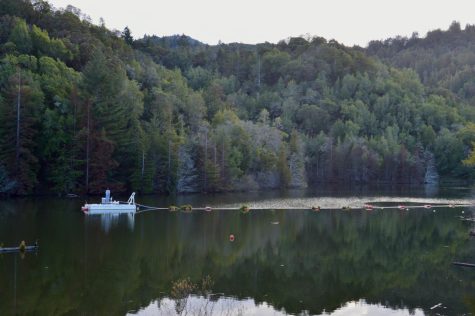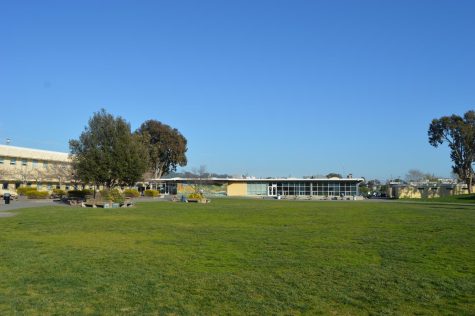On Tuesday, Jan. 18, the Marin Water Board of Directors voted unanimously to repeal customer water-use limits and associated penalties set earlier this winter. The action to nullify Ordinance No. 454, established on Dec. 1, 2021, came in response to recent rainfall restoring local reservoirs to near-full capacity after a year of alarmingly low water levels.

As of Jan. 27, reservoir storage capacity sits at 96 percent compared to the 56 percent capacity on this same date last year. Yet, with the Board’s decision to revoke these water-use restrictions, Marin Water communications manager, Adriane Mertens, reminds residents of California’s unpredictable climate variability and encourages the community to keep up their water-saving practices.
“We want residents to remember how quickly we can return to a water shortage,” Mertens said. “We know our reservoirs are full enough to get us through the next year or two, but if we have another dry year or two, we could be back in the same place we were [in most of 2021].”
Advanced placement environmental science (APES) teacher Mitch Cohen also advises others to continue to use water with caution and consider Marin’s historical trend of droughts.
“I think that people should really get in the habit of conserving because, even though the reservoirs might be in good shape for the moment, climate changes aren’t going away, and we’re going to see other droughts down the road,” Cohen said. “People need to view water as a valuable resource and not waste it.”
Having experienced many of Marin’s devastating droughts, Cohen integrates several water-conserving habits into his lifestyle. At home, Cohen uses low-flow showerheads and toilets. In his yard, he saves water by turning off his drip irrigation and collecting rainwater through a catchment system. He then uses the rainwater to self-irrigate his lawn.
“It doesn’t make a single bit of difference to me that my [low-flow] toilet takes one and a half liters to flush versus three or four gallons. It still does the job,” Cohen said.
To combat future water shortages in Marin, Cohen additionally claims that the price of water should reflect its utility.

“Water is really cheap. We get a gallon of fully treated drinking water delivered to our house when we just flick a switch, and that costs about a penny,” Cohen said. “I’ve always challenged students to try and think of anything that you can buy that is a better value than one gallon of fully treated drinking quality water delivered to you on demand.”
Marin Water already partially reflects this concept in their tiered pricing system: a cost structure aimed to promote water conservation by charging residents different rates that increase with water use. However, one of Cohen’s annual in-class labs in which students examine their water bills from home repeatedly reveals that, for many families, the prices are not set high enough to reduce household water use.
“As long as you’re using water below the first tier, then it can be cheap, but when people go over that allotted amount, I think that the tiered pricing system could become more severe. I’ve had students that have had water bills that are up in the thousands of dollars because they have a pool and they have a spa and they have a lawn,” Cohen said.
According to a January 2021 Bark survey, 67 percent of Redwood students take action to consciously conserve water when they can. Motivated after taking APES with Cohen during her junior year, senior Katherine Ritter now reduces her water use on a daily basis. Her conservation efforts include placing a bucket in her shower to collect greywater, a name for uncontaminated domestic wastewater. She then uses the excess water to sustainably flush her toilets. Ritter encourages other students to start open conversations with their families about realistic water-saving goals.
“[Saving water] is actually pretty simple,” Ritter said. “Yes, it does require a little bit of planning, but once you start doing it, it’s really easy to continue and it’ll make you feel good for doing something good for the environment. I recommend that others talk to their families, see if everyone is willing to commit to and make a plan to cut back on water, whether that’s taking fewer showers or reusing greywater.”

As APES paved the way for Ritter’s water-conscious behavior, she hopes others will take advantage of opportunities in and outside of school to learn more about water systems and conservation.
“People see water as a kind of a resource that’s really easy to waste and they think it is a really abundant resource. I think a lack of education on the actual problem is why more people don’t conserve,” Ritter said.
Even with near-full reservoirs and Marin Water’s decision to rollback restrictions, Ritter plans to maintain her current water-saving routine.
“I know how quickly things can change, and just because we are having a good year doesn’t mean that every year is going to be a good year,” Ritter said. “It may be good that [Marin Water] is relieving stress for people who freaked out about water restrictions, but I think it’s very important to continue to be conscious so we do not get back to that place that we once were.”
The Marin Water Board of Directors plans to meet again on Feb. 15 to discuss further modifications to restrictions that remain in place like irrigation limits and bans on pool filling. In the meantime, live updates on reservoir water levels can be found at https://www.marinwater.org/water-watch.







